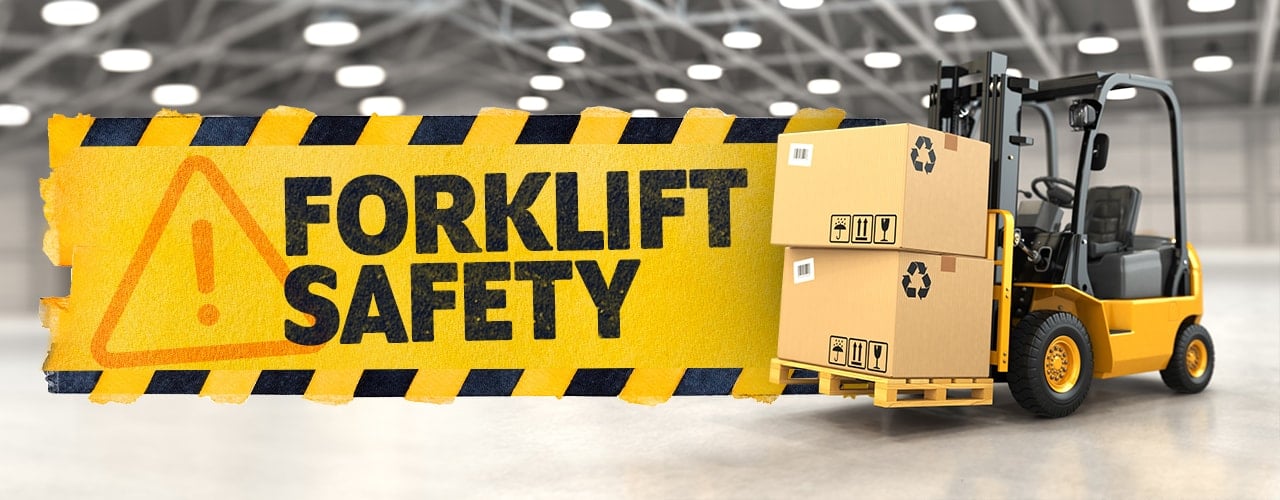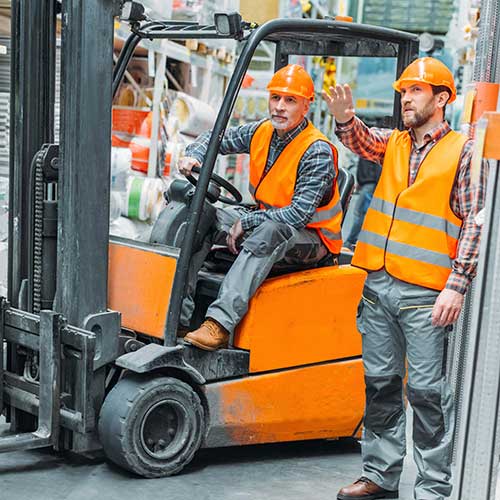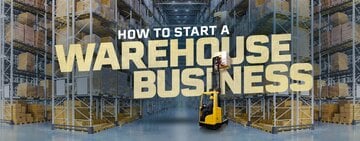
When it comes to keeping your warehouse safe, there are many factors to take into account. The busy and fast-paced warehouse environment can create many opportunities for accidents to occur, with one of the most common types being forklift accidents. In the article below, we’ll investigate what you can do to promote forklift safety in your warehouse.
Shop All Industrial SuppliesForklift Safety Tips
Forklift accidents can result in serious injuries to your employees and damage to your workplace. The Occupational Safety and Health Administration (OSHA) has established several rules and regulations designed to keep employees safe. Below, we’ve compiled a list of tips to help you create a safe workplace and reduce the risk of forklift accidents.
1. Forklift Certification Test
Per OSHA, forklift certification tests are required by law. By requiring your employees to get trained and licensed in forklift operations, you can improve their industry knowledge and adhere to local and federal regulations. Furthermore, getting additional certifications can lead to further career development, with certified employees being eligible for higher wages. Organizations such as the National Forklift Foundation offer certification courses that meet OSHA standards and can be completed online. It’s important to remember that these certifications must be renewed every few years to stay up to date on the latest safety procedures.
2. Establish a Dress Code

One of the easiest ways to reduce the risk of a forklift accident is to adopt a dress code. Your dress code policy should outline what is appropriate for your employees to wear to work and what isn't. The dress code can vary depending on the position a person is hired for. It's important to note that in some areas, there may be laws or requirements that require certain equipment to be worn in a warehouse. For this reason, you should always make an effort to research any local, state, or federal safety regulations.
When it comes to setting a dress code for your forklift drivers, there are several factors to consider. Be sure to take the day-to-day responsibilities of the job as well as the environments they'll be working in to account. As you formulate your forklift driver dress code, focus on the following points:
- Job function: Consider where your employees work and what they do daily. Providing them with uniforms featuring company branding can make it easy to identify their work location, especially if you own several warehouses. Considering the needs of their job can help to improve efficiency in the workplace.
- Safety: Prioritizing safety is an easy way to avoid unnecessary accidents. Consider supplying your employees with safety apparel to protect them from hazards in the workplace. This can come in the form of hard hats, protective eyewear, or even gloves.
- Comfort: It is important to keep your forklift drives comfortable during their shift. Their warehouse attire should fit loosely, but not put them at risk of getting caught on nearby equipment.
3. Understand Different Forklift Types
There are several different types of forklifts, each of which serves a different function. Depending on the type of materials you handle, you may have multiple types of forklifts in your workplace. These different forklift classifications can have varying safety features, making it essential that you identify the differences between them. What is considered safe on one type of forklift may not be safe on another. Educating your workers on what sets them apart from one another can help to avoid unnecessary accidents.
According to OSHA, there are seven different forklift classifications. We've included a list detailing each one and what they do below:
- Electric motor rider trucks: Intended for use indoors and on smooth floors, these forklifts are typically battery-powered and can serve many purposes.
- Electric motor narrow aisle trucks: Optimized for small spaces, these forklifts help to maximize speed and efficiency.
- Electric motor hand or hand-rider trucks: These forklifts are hand-operated and typically feature a smaller capacity than others.
- Internal combustion engine trucks (cushion tires): Optimized for use transporting pallets of goods, these forklifts are designed to be lower to the ground and fit through spaces with low clearance.
- Internal combustion engine trucks (pneumatic tires): These forklifts are designed for both indoor and outdoor use and are designed for holding larger capacities.
- Electric and internal combustion engine tractors: Compatible with two different types of engines, these forklifts offer superior versatility compared to their counterparts.
- Rough terrain forklift trucks: Designed for outdoor use, these forklifts can traverse rough terrain and lift heavy materials.
4. Perform Daily Inspections
As is the case with most heavy equipment, your forklifts should be inspected. OSHA requires that forklifts be inspected daily. A thorough inspection can reduce the risk of mechanical damage and protect your employees from injury. These inspections should be performed by a certified employee or supervisor to ensure any problems are identified. Consider using a daily checklist to keep track of what needs to be inspected. Consider keeping a log of any maintenance or issues that arise with your forklifts for future reference.
Visual checks
- Damage: Check the body of the forklift for any broken or bent parts.
- Leaks: Inspect your forklift to check for any leaking fuel, oil, or hydraulic fluid.
- Tires: Ensure that your tires, wheels, and casters are in working condition.
- Forks: Verify that the forks of your forklift are secured and in good condition.
- Chains, cables, and hoses: Check that all chains, cables, and hoses are in good shape.
- Guards: Look at any guards, gates, or side rails to verify they are in place and maintained.
- Safety measures: Inspect any seatbelts, fire extinguishers, and warning labels to ensure they are functional.
Operational checks
- Startup: Check that your forklift starts up properly and any indicator lights or alarms work as expected.
- Controls: Verify that the steering wheel, pedals, and any other controls are functional.
- Electrical safety features: Inspect your horn, lights, and other signals to make sure they function correctly and alert nearby workers.
- Steering: Move the steering wheel to make sure it works effectively.
- Brakes: Inspect your forklift’s brakes, ensuring that they work at both lower and higher speeds. Also, take time to verify that your parking brake is in good condition.
- Hydraulic controls: Verify that your forklift operates smoothly and doesn’t make any strange noises.
- Attachments: If your forklift uses any attachments, ensure that they are in working condition.
- Battery: Check your forklift’s battery and make sure it is charged.
5. Label Your Warehouse
Putting clear and direct labeling in place as you set up your warehouse can reduce confusion and help to improve navigation. As a result, the risk of employees walking out of place or a forklift going somewhere it shouldn't be is diminished. Creating visual cues for your team can improve productivity. Some ways that you can label your warehouse include:
- Warehouse floor marking: In most cases, warehouse floor markings are made using paint, floor stripping, or tape. These markings can be used to designate different spaces, direct traffic, and even call attention to hazardous areas. You can take steps to create clear lanes for your forklifts to drive through.
- Storage labeling: Labeling your racks, shelves, and other storage areas can help employees identify what products they are handling. Consider using warehouse signs to notify employees of where they are and what safety precautions they should take. You can display the width of an aisle and how much clearance your forklifts will have before entering.
6. Keep Capacity in Mind

You must educate your employees on the dangers of trying to carry objects that are too heavy for a forklift. In particular, it is important to make sure you never exceed the counterweight listed for your forklift. Doing so can cause the machine’s rear wheels to rise off the ground, ultimately causing it to fall over.
Loading too much weight onto a forklift can cause permanent damage to the machine and your products. Even worse, it could cause an employee to get injured. Take steps to identify the maximum capacity of each forklift you own and remind your employees of the dangers of trying to lift too much. Remember that any attachments you might use with your forklift may have their own weight capacity which you should take into account.
7. Secure Loads
An unsecured load is a danger to forklift operators and bystanders alike. Even if you are transporting goods a short distance, moving with an unsecured load can cause serious damage. In a busy warehouse environment, there are many opportunities for an accident to occur. For that reason, you and your employees should always take steps to secure loads before you begin moving them. Adhere to the tips below to limit forklift overturns and load-based accidents in your workplace:
- Use proper equipment
- Secure any attachments to the forklift itself
- Avoid picking up damaged loads
- Ensure load is centered
- Do not exceed capacity
- Approach loads carefully
- Move with the mast tilted back to stabilize load
- Check for adequate overhead clearance while moving
8. Drive Safely
Ultimately, the easiest way to promote forklift safety is to promote safe driving. Securing loads, performing inspections, and labeling your workplace can create a safer environment, but without safe drivers, there is still a chance for accidents to happen. Investing in a forklift driver training program and taking steps to optimize your workplace for forklift navigation can go a long way in protecting your employees. Below, we've included several examples of what constitutes forklift driving:
- Drive slowly
- Keep loads low to the ground
- Avoid sharp turns
- Avoid uneven surfaces
- Stop and start slowly
- Keep load secure and stable
The Three Point System
When entering or exiting a forklift, it is recommended that all employees adhere to what is known as the three point system. Also known as the three point dismount, this method can be applied to a variety of heavy machines and vehicles. The three point system states that an employee must have three points of contact as they enter or exit a forklift, which can come in the hand of one hand and two feet or two hands in one foot. Doing so helps to keep employees stable as they climb in.
9. Avoid Hazards
When it comes to forklift safety, the responsibility is not just on the forklift drivers, but also on the people in the surrounding area. Making an effort to train all warehouse employees about the dangers of forklifts can be beneficial in the long run. Knowing how to stay safe in the presence of a forklift, what to watch out for, and how to adhere to safety requirements can help your employees create a safe workplace. Be sure to educate your employees on the following points to increase forklift safety awareness in your workplace:
- Keep a safe distance from operational forklifts at all times
- Avoid walking near or underneath raised forks
- Be cautious when rounding corners or entering doorways
- Ensure that the operator sees you as you walk by
- If a forklift is in operation, wait for it to move before walking past
10. Designate a Forklift Parking Area

Creating a designated parking area for your forklifts can reduce workplace confusion and ensure that they are never out of place. If you don’t have a designated parking area or an employee leaves a forklift in the wrong place, it can become an obstacle and impede your progress.
The following tips are recommended by OSHA to aid employees as they park a forklift:
- Only park on a hard, level surface
- Avoid parking on an incline
- Ensure forklifts are parked away from any fire equipment or stairways
- Always use the parking brake
- Tilt mast forward
- Lower forks to the ground
The safety of your employees should be your top priority, no matter what kind of workplace you work in. Different work environments can present different risks, meaning that each business can have different safety considerations to take into account. By educating yourself on forklift safety, you can reduce the risk of forklift-related accidents in your workplace and keep yourself and your employees safe.





